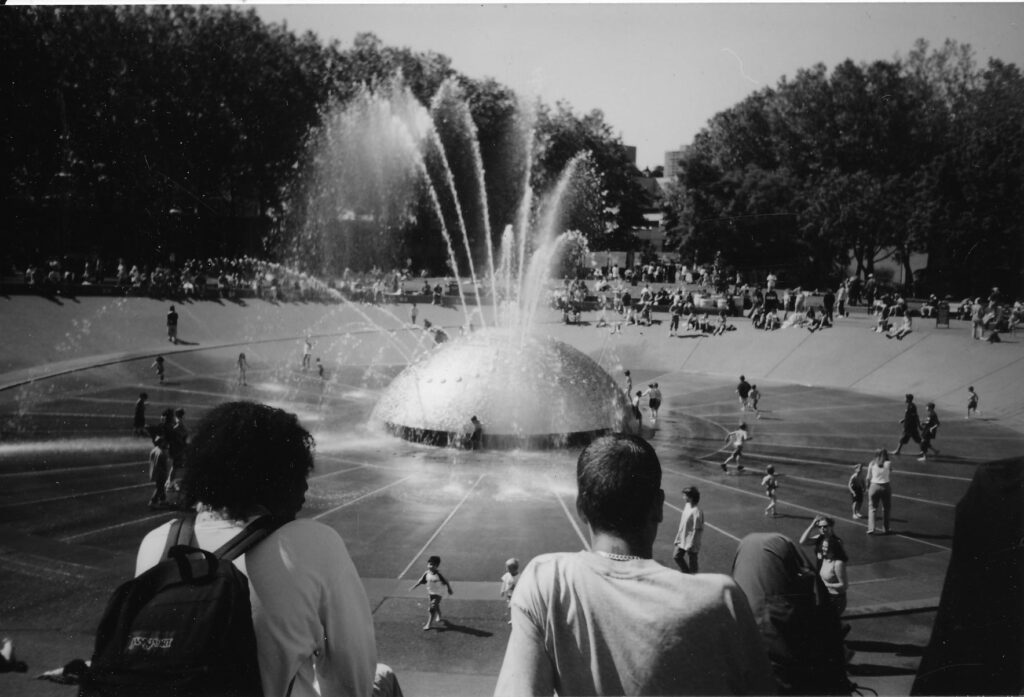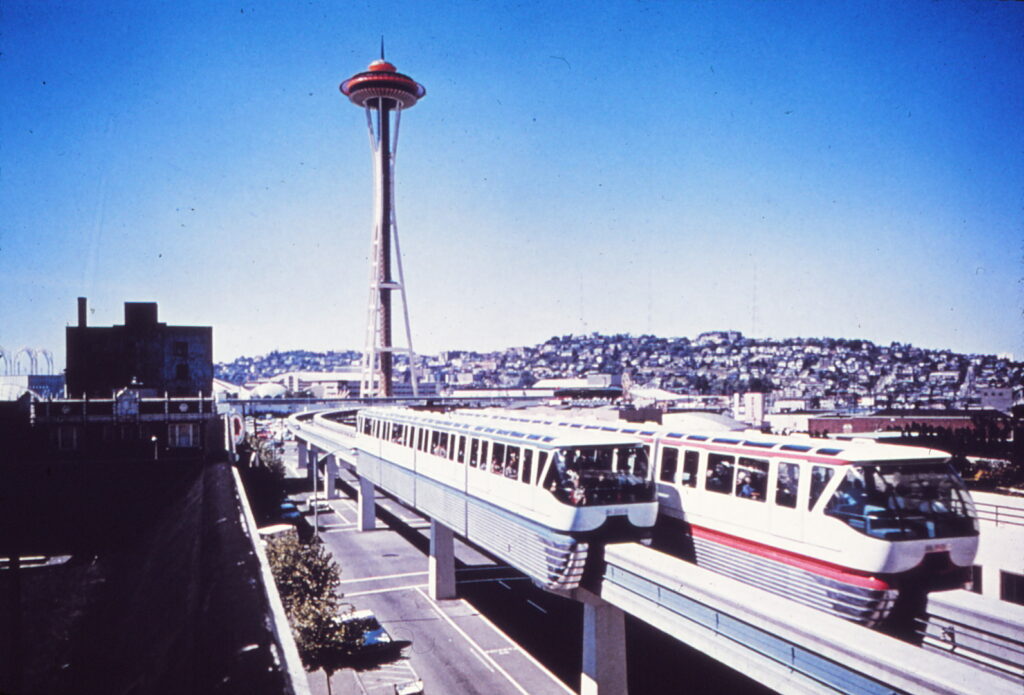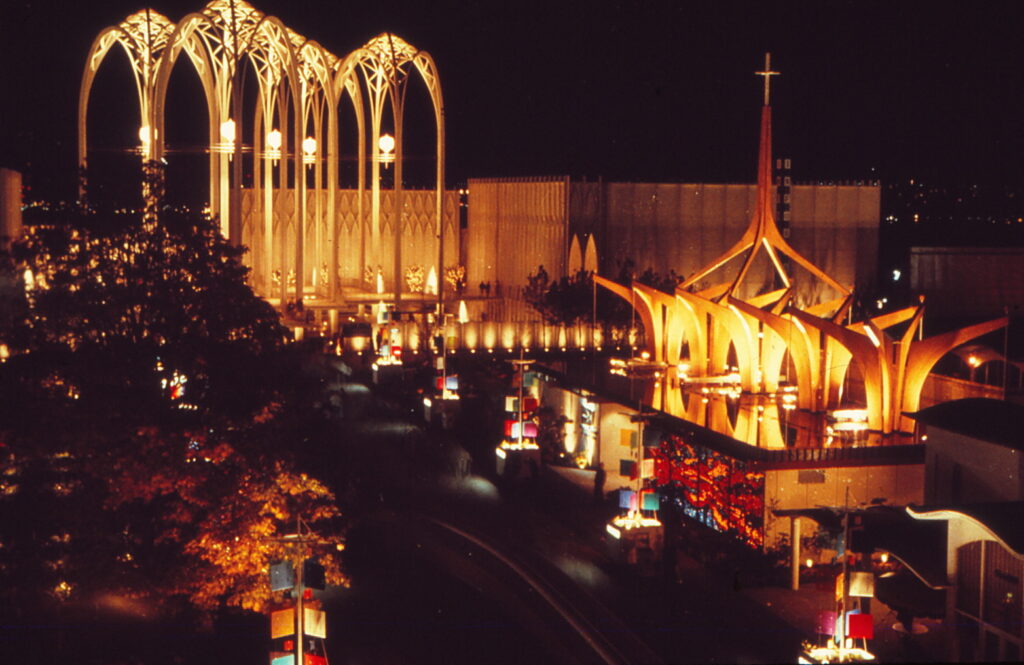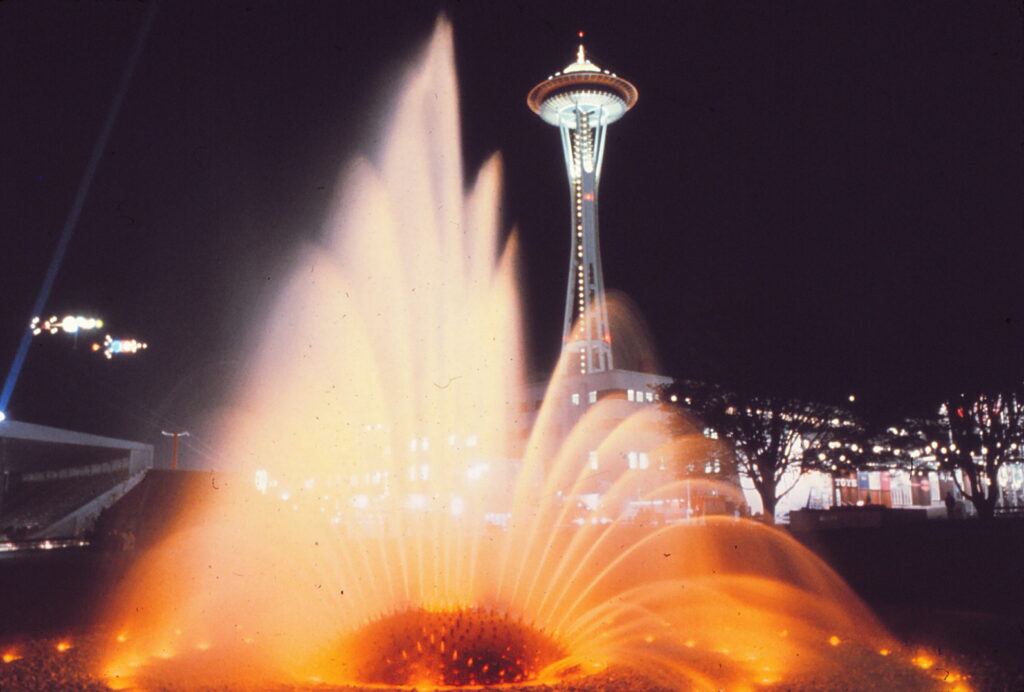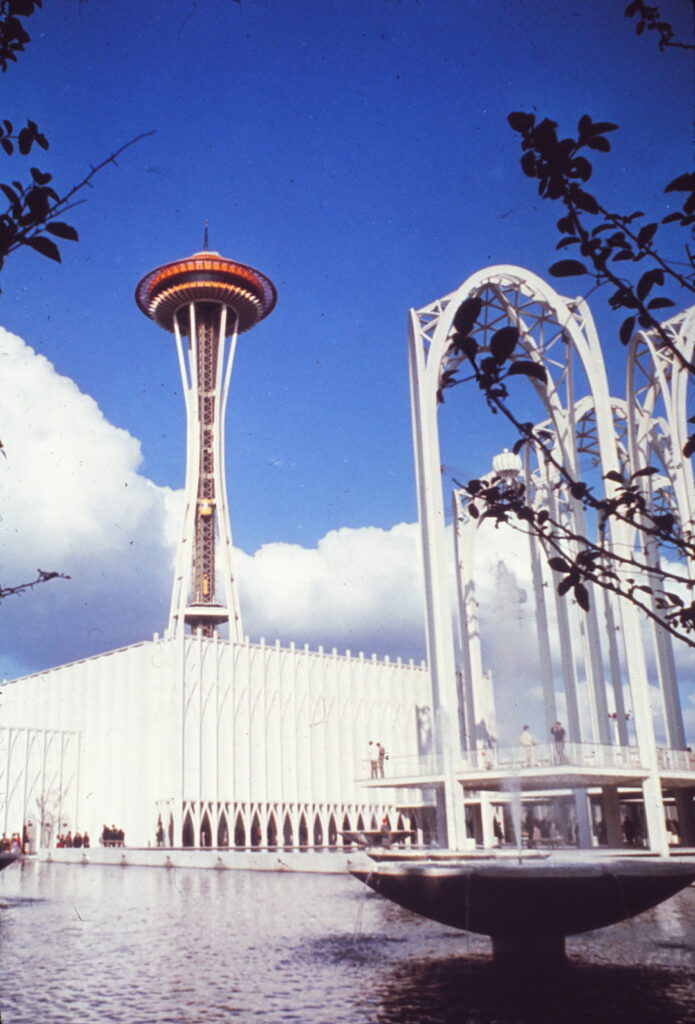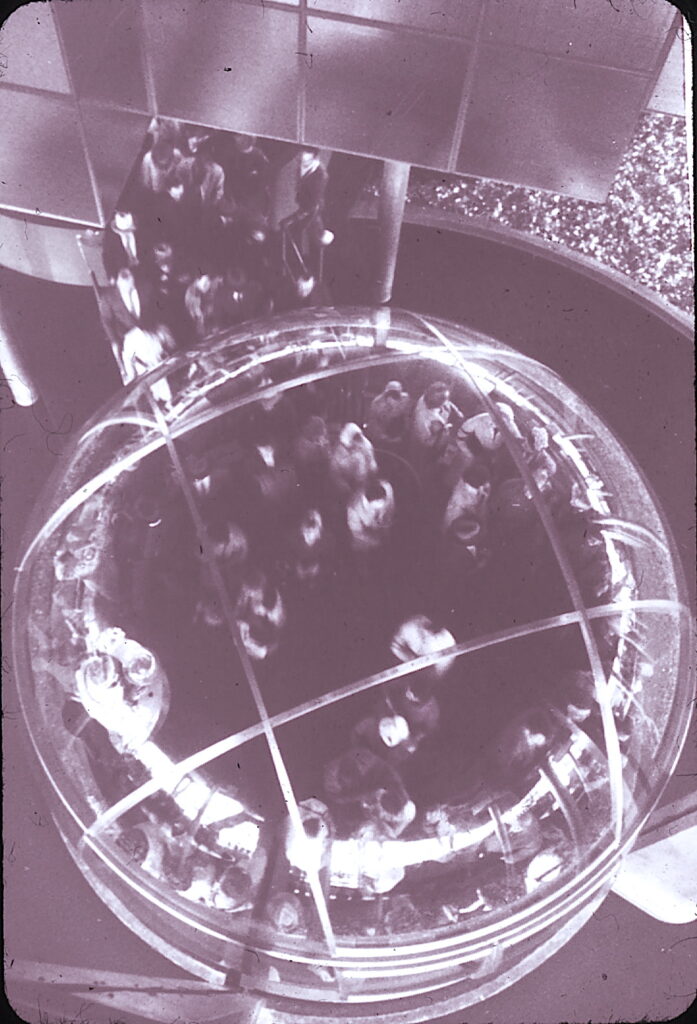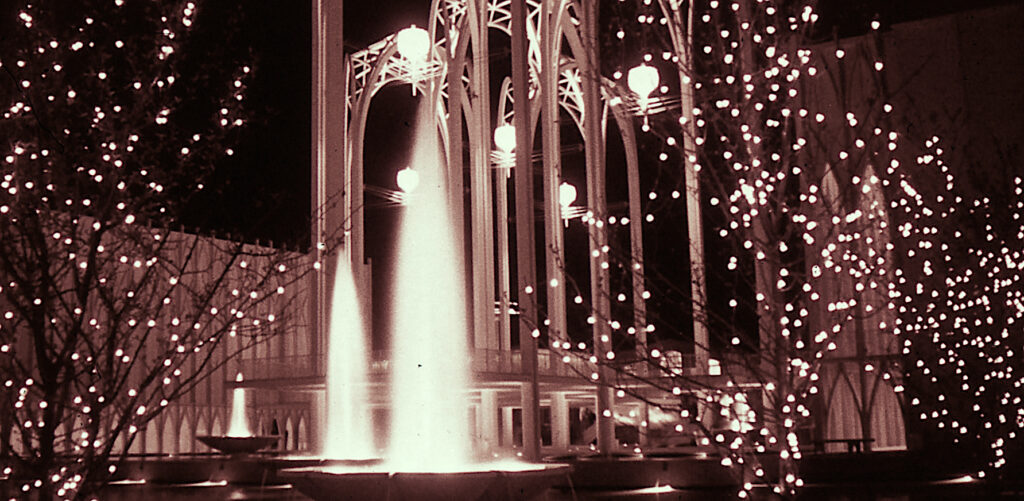When Seattle’s music and arts festival, Bumbershoot, rolls around every Labor Day weekend… I feel bittersweet pangs of poignancy. As I now write of it from 2,400 miles away, I’ve realized that my fuzzy-warm memories have even more to do with the festival’s site – the Seattle Center. The magic, the always-pleasant atmosphere of that place took hold of me as a child in the 70s, and endures to this day.
The Seattle Center – the grounds at the base of the iconic Space Needle – are the largely intact remnants of the 1962 World’s Fair. Most of the really cool stuff from the Fair (which was actually the spearhead of a real estate scheme) was somberly stripped away after the event closed, but key structural elements remained. The grounds were not at the city’s geographical center, but they nonetheless became Seattle’s cultural, artistic and educational core.
Seattle used to have all sorts of clever, architecturally notable attractions for its residents and visitors – from an Atlantic City-type boardwalk on a mini-peninsula to a grand, saltwater swimming pool downtown. Almost everything had been razed and/or replaced by blandishment, decade by decade, by the time of the Fair. The Seattle Center, while celebrating the future, was almost an apology for past missteps. Or, for the pragmatic, just a consolidation of future amusement opportunities.
As a kid, I lived just across a country road from Everett’s city limits – roughly 30 miles up the freeway from Seattle. The excitement of the Jet City seemed like a day’s wagon ride away, and that perception wasn’t just for young people. Life was different back then. My parents would occasionally take my brother and I to the bright lights, but only for touristy destinations. The Kingdome, for Seahawks and Mariners games; Pike Place Market and the waterfront, or the zoo – maybe once a year. We went to the Nordic enclave of Ballard a few times back then, to see the locks and fly kites at adjacent Gasworks Park. It seemed that we went to the Seattle Center at least twice a year, for some reason or another. The rest of Seattle… a mystery. Most of what us kids saw of the town was through a car window – until we were old enough to buy a car window of our own.
The Seattle Center afforded my brother and I not only the most physical freedom we could enjoy in town, it’s buildings offered something for just about everyone. There was Supersonics basketball and concerts at the Coliseum-turned-Arena (The Bee Gees in ’79, my first there); my father, a man of science, bonded with his sons over hands-on exhibits at the Pacific Science Center (which also houses a great IMAX theater). My mother stood in line with her boys for hours one Saturday morning in 1978 to see the King Tut exhibit. There was dance and song at the Opera House — the incredible (and now retired) run of the Maurice Sendak version of “The Nutcracker” was a tradition that lasted for more than a generation. The immense, multi-purpose Center House… inexplicably, it dismissed it’s Fair-era “Bubbleator” elevator 40 years ago – but I remember it well. There was so much more to do at the Center, but the thing that I enjoyed the most was merely walking around the grounds. There were amusement rides (the Fun Forest, originally dubbed “The Gayway”) and carnival-like games of skill to save lawn mowing money for. There were beautiful lights at night; it was a great place to walk with a date.
The Space Needle? Yeah, we would go up once in every couple of years or so – usually if we were entertaining visiting family. It cost money – and a ticket doubtlessly costs a lot more money now. I remember eating up at its revolving restaurant just once – for my brother’s birthday in the late 70s. Note: For most visitors, the ride up in the elevator is the best (and/or scariest) part. I’ve known people to refuse to go up, once they took a good look at that elevator rising.
All of this was connected to downtown via a futuristic-looking, elevated tram – the Monorail. People traveled the short distance more for its novelty value; later, fruitless pushes were made to expand the Monorail to other parts of the city.
For us, the Seattle Center <was> the city. And once a year, the grounds really represented Seattle — for the Bumbershoot festival. With a schedule of local acts that I’d only read about in The Rocket peppered with international musicians, it was an astounding experience. It was almost a carnival atmosphere, with amazing food and side performers. The Center was flooded with people from all over – but back in my salad days it was never crowded. Unlike Lolla and WOMAD and everything that came after ‘em, Bumbershoot was manageable. There wasn’t the agony of a tortured bladder in a long potty line, and you weren’t crammed genitalia-to-ass in a concert-watching crowd. Manageable, and a perfect vibe.
In the 80s, a party of four teenagers with maybe fifty bucks between them could have a good afternoon (or evening) at the Center. Sometimes, we got by with a lot less – hell, I remember eating for what seemed to be hours on a few dollars, courtesy of a disastrous – for McDonald’s – promotional campaign (Google “1984 McDonald’s Olympics” sometime). Moreover, it was a “safe space” for people – especially young people – to have a good time. Nobody was there to make trouble. The most excitement one might experience is to have been buzzed by a flight of skateboarders on a quiet midnight (fewer cops around).
Yes, when you’re sixteen or so, family traditions sometimes segue into rites of passage. Going to the Seattle Center on a sunny summer Saturday – or for Bumbershoot – with friends; going with your girlfriends. The first time I went to a laser show at the Center was with my first “real” girlfriend; I believe that it was “Laser Van Halen,” but entirely sure; it didn’t matter at the time. Now that I think of it, two of the best dates I’ve ever had concerned the Center’s Opera House; one of them was with a girl whom I’ve never kissed.
Twenty years after I graduated from high school, my late wife and i – both journalists – would walk hand-in-hand around the Center after an IMAX premiere or science exhibit debut. Still a great atmosphere, still a safe place. The romance was still there.
I first visited the Seattle Center as a tourist on vacation from Minneapolis. I was seven years old, but I still have vivid snapshot-recollections. I remember a display of antique fire trucks; it’s no surprise how they burned themselves into a kid’s brain. Mostly, though, I recall it being very quiet there amongst these towering structures. Monoliths of an age passed, but still shiny. Seattle was in a deep recession, and ironically the Jet City – long a very livable town – was at a height of livability. None of that registered on a little boy, of course. I just thought it was the greatest thing, almost like the Disneyland I’d see on Sunday evening tv. I started going to this version of Disneyland regularly the next year, the bicentennial year. Minnesota was almost forgotten.
Minor things came and went after the Seattle World’s Fair, but the Center remained basically unchanged until the turn of the century… until Paul Allen built the misshapen, highly controversial Experience Music Project on one edge of the grounds. At the time, I kept my mind open as a resident and as a journalist. Perhaps the Center could use some new blood, I thought. Ultimately, however, I concluded that the EMP was a poor fit. More of a project for the whims of Paul Allen and architect Frank Gehry than for the good of a city whose populace it never seemed to connect with. The mollusk-shaped building was also, perhaps coincidentally, a harbinger of things to come – or a gleaming, funhouse mirror of things already happening. … yet, through it all, the Seattle Center managed to maintain a strong semblance of the atmosphere that kept me coming back.
The Fun Forest that I once so enjoyed was aging, and sadly soon to be phased out. The increasingly affluent “Emerald City” looming over the Center’s borders was rapidly becoming less livable, less of place for what we used to call “regular folks.” Bumbershoot – which was free to the public in the 70s and next-to-free in the 80s – started charging more and more for admission – and the crowds seemed to respond by growing larger and larger. My favorite haunts began to disappear, replaced by testaments to locust-like greed. By 2003, I’d almost disappeared, myself – priced out of Seattle, I bought a house north of Everett.
To borrow from The Pretenders, my city was gone in a seeming blink of an eye. Even the “secret” free parking spots behind the Center had vanished. Heck, before too long the primary route to the Center itself was unrecognizable. I attended my last Bumbershoot in 2007, covering the event for a magazine. My last visit to the Seattle Center was a fleeting one – seeing Hall & Oates in 2018. i was there just long enough to see that the unique vibe of the grounds, surprisingly enough, hadn’t changed much; it was still a bubble of both relative serenity and excitement – perhaps even more so, given the city’s accelerating degeneration that was thinly disguised as rebirth.
Washington State seemed to catch Seattle’s fever of financial excesses, and I left it in 2021. I still receive regular reports about the city from friends left behind, usually notes about another totem of our youth being chopped down. But news from the Seattle Center remains bright. The Opera House, remodeled into McCaw Hall, is doing well. The NHL came to Seattle, at an Arena now named after furniture polish. And Bumbershoot returned this year, after a hiatus induced by Covid and financial challenges. A day’s ticket this weekend cost $75; deemed reasonable by those who can afford to live within a few hours of the city.
The Seattle Center is essentially the same, my friends say. It’s still good to walk around on warm, late-summer nights. This pleases me, to know that my memories of happiness past have an anchor in the present… in a 21st century that the visionaries behind a 1962 World’s Fair could’ve never predicted.
(Any old photos I might’ve snapped at the Seattle Center are long gone. I took the b&w photo of the fountain in 2000; the photo of the fountain and reddish stage is of Bumbershoot 2023, taken by my friend Linda Gwilym. The rest are from 1960s Panavue and Morley slides)
